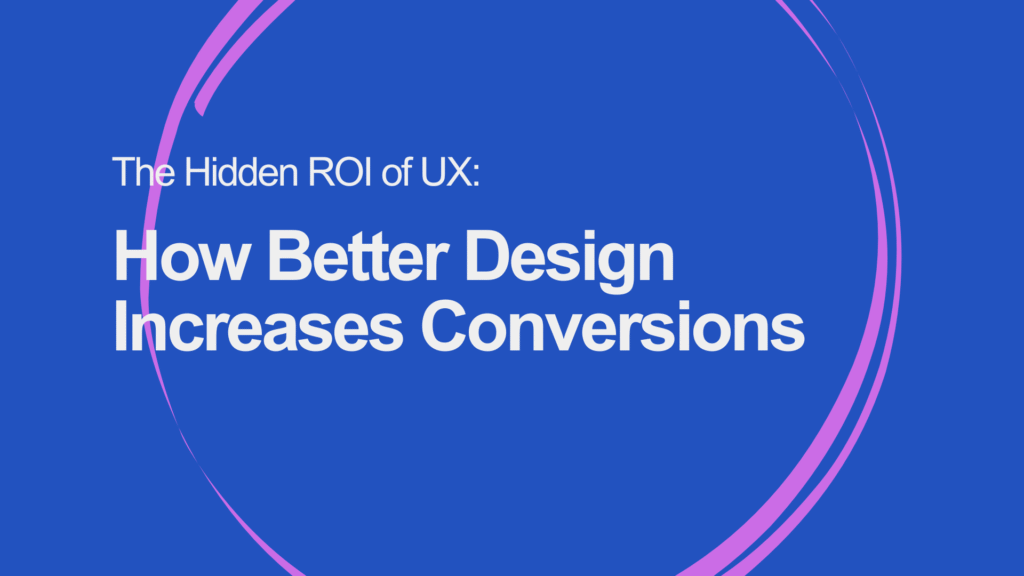Most founders and product teams treat UX design like it’s something you deal with after you’ve built the product, or when the user complaints start piling up.
But here’s what they’re missing:
Great UX doesn’t just make a product easier to use.
It makes your product more profitable.
That’s because good user experience leads to less friction, better retention, faster onboarding, and more signups. In other words, UX design for conversion isn’t optional. It’s one of the smartest investments a SaaS business can make.
Let’s break down how and why improving UX can directly help you increase SaaS sales.
What Is UX ROI (And Why Most Teams Overlook It)
Return on investment (ROI) is a simple idea: put something in, get more out. But when it comes to UX, the return isn’t always obvious, and that’s why many teams undervalue it.
What’s easy to see:
- Cost of redesigning pages
- Time to update product screens
- Developer hours needed
What’s harder to see:
- Confused users abandoning trial signups
- Poor onboarding leading to low retention
- Frustration driving up support costs
- Lost referrals due to clunky design
The returns from UX may not always be flashy, but they’re not poor either. When you make things easier, faster, and clearer for your users, you remove barriers to action. That’s how UX increases conversions in a way marketing alone never can.
Better UX = More Conversions (And Here’s Why)
Let’s break down how UX impacts every stage of your user journey from signup to success.
1. Faster Signups with Less Drop-off
When was the last time you stopped signing up for a product because it was just too annoying?
Chances are, it wasn’t because the product didn’t seem good; it’s because the experience got in your way. Maybe the form was too long. Maybe you couldn’t figure out what was required. Or maybe there was no progress bar, and you felt stuck.
Clean UX solves this issue.
By designing intuitive, simplified signup flows, with logical steps, helpful instructions, and minimal friction, you keep people moving forward on your website.
2. Onboarding That Activates and Excites
It’s not enough to get a user signed up. You need to help them succeed.
Good onboarding UX creates a bridge between interest and value. It guides users toward their first win quickly.
This might look like:
- A personalized welcome screen
- A product tour highlighting top features
- A checklist that builds confidence
- Micro-copy that explains decisions clearly
The faster a user feels like “this tool gets me,” the more likely they are to upgrade or stick around.
That’s what drives conversions, upgrades, and happy customers.
3. Reduced Support Load (and Hidden Costs)
Every time someone has to ask, “How do I do this?” It’s a sign your UX could improve.
Poor design creates confusion. Confusion creates support tickets. And support tickets create cost, not just in time, but in trust.
If a user needs to email support just to find a feature or complete a task, they’re already frustrated.
Investing in better UX means:
- Clearer navigation
- More helpful microinteractions
- Self-service tools like tooltips or contextual help
The fewer times users feel stuck, the more time your team has to focus on growth, not damage control.
4. Trial Users That Turn Into Paying Customers
This is the one every SaaS founder cares about: trial-to-paid conversion rate.
What pushes someone from a free trial into a credit card submission? It’s not just features. It’s confidence. And confidence comes from clarity.
Great UX helps trial users:
- See value quickly
- Understand what to do next
- Explore without fear of breaking something
- Complete tasks without needing help
When users feel in control and successful, they convert.
That’s UX design for conversion in its purest form.
5. More Referrals (Because People Share What Works)
People don’t recommend products that frustrate them. But when something feels simple and genuinely helpful, they can’t help but share it.
You might not think UX has anything to do with referrals, but it does.
When your product is easy to use and delightful to interact with, it builds trust. And trust leads to recommendations.
If you’ve ever heard someone say, “You’ve gotta try this, it’s so easy,” you’re witnessing UX-fueled word of mouth in action.
Common UX Mistakes That Are Hurting Your Conversions
Even small UX issues can cause users to hesitate, drop off, or never return. Let’s examine the most common ones that kill conversions and suggest what to do instead.
❌ Too Many Steps to Get Started
If your signup or setup process feels like a long obstacle course, people will abandon it. Fast.
Every additional field or unnecessary page adds friction. And friction leads to lost conversions.
Fix it by trimming unnecessary steps, enabling social logins or email-only signups, and showing users how far along they are. The goal? Making their user journey easier.
❌ No Clear Next Action
One of the most common UX failures is not making it obvious what users should do next.
You land on a page… and then what?
If your users have to guess, you’re losing them.
Fix it by designing with intent: every page should lead somewhere, and every button should clearly say what it does. Use hierarchy, spacing, and color to guide action.
❌ Cluttered or Overwhelming Dashboards
More is not better, especially on your homepage or dashboard.
When everything is shouting for attention, nothing gets noticed.
SaaS companies often want to “show off” every feature, but this just confuses new users and overwhelms returning ones.
Fix it by simplifying layouts, grouping related content, and prioritizing the most important tasks. Think “clarity first,” not “cram it all in.”
❌ Not Testing With Real Users
Assuming your design works because your team likes it is risky.
Users often behave in ways you don’t expect: skipping buttons, missing links, or misunderstanding text.
Fix it by running even basic usability tests. Get feedback early. Watch how new users interact with your product. It’ll highlight issues faster than any analytics tool.
❌ Ignoring Mobile UX
With about 62.69% of global web traffic coming from mobile, ignoring it is conversion suicide.
A design that works beautifully on the desktop can feel broken or frustrating on mobile if not adapted properly.
Fix it by designing mobile-first layouts, testing on multiple devices, and simplifying actions for touch screens. Every tap should feel intentional and easy.
UX Isn’t a Luxury — It’s a Growth Strategy
Design used to be seen as something aesthetically pleasing. Now it’s a strategy.
When your product is easy to use, people finish what they start and also tell others about it. When it removes friction, your conversion rate goes up.
It doesn’t matter how brilliant your backend is, how generous your pricing is, or how advanced your features are; if the user experience is poor, users won’t stick around.
But when is it good? They sign up, stay, upgrade, and refer.
That’s the hidden ROI of UX, and it’s far more powerful than most teams realize.
Want to Turn Your UX Into a Growth Engine?
At Bilzimo, we help SaaS and B2B companies redesign their UX to increase conversions, reduce churn, and drive user love. Whether you need a fresh onboarding flow or a full product audit, we’ll help you turn design into ROI.

